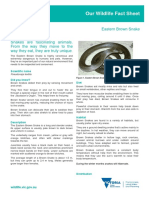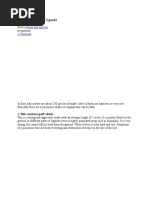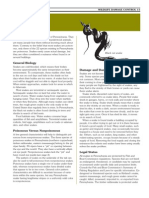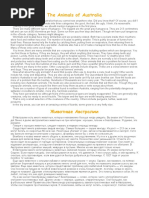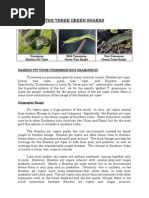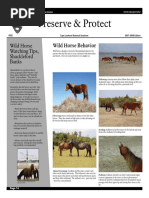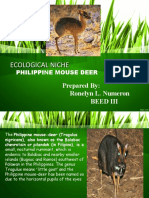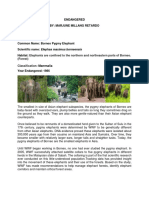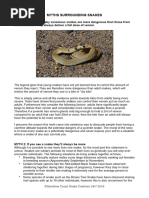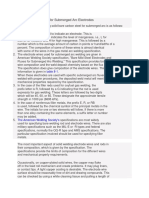Snakes Commonly Found in Central Queensland
Snakes Commonly Found in Central Queensland
Uploaded by
vitaCopyright:
Available Formats
Snakes Commonly Found in Central Queensland
Snakes Commonly Found in Central Queensland
Uploaded by
vitaOriginal Description:
Original Title
Copyright
Available Formats
Share this document
Did you find this document useful?
Is this content inappropriate?
Copyright:
Available Formats
Snakes Commonly Found in Central Queensland
Snakes Commonly Found in Central Queensland
Uploaded by
vitaCopyright:
Available Formats
Wildlif e I n f orm a t ion
Conservation and protection What you can do… Snakes commonly
Snakes are among the least understood of Australia’s
fauna. Snakes are often unnecessarily killed due to
Snakes are frequently encountered during warmer months
and should be treated with extreme caution.
found in Central
Queensland
incorrect identification and the false perceptions that
‘all snakes are dangerous’ and ‘the only good snake is a Don’t approach snakes
dead snake’. Remove rubbish piles
Snakes usually prefer to retreat but can become Learn first aid treatment for snakebite
defensive if threatened. Most snake bites are received
by people in the process of trying to capture or kill a
snake. They present little or no danger to people when Further reading
left alone.
Cogger, H.G. (2000) Reptiles and Amphibians of Australia
Snakes are essential to maintain an ecological balance
(6th Ed.), Reed New Holland Pty Ltd.
as they help maintain natural populations of frogs,
rodents and even other reptiles, some species even Shine, R. (1998) Australian Snakes – A Natural History, Reed
control cane toads. If we follow a few simple rules and New Holland Pty Ltd.
treat all snakes with a healthy respect, we can coexist.
Torr, G. (2000) Pythons of Australia – A Natural History,
Keeping snakes in Queensland requires a licence from UNSW Press Ltd.
the Queensland Parks and Wildlife Service. Snakes are
Wilson, S. and Swan, G. (2003) A complete guide to Reptiles
protected under the Nature Conservation Act 1992 and
of Australia, Reed New Holland Pty Ltd.
cannot be killed or taken from the wild. Only snakes
bred in captivity by a licensed person can be purchased Photography: John Augusteyn, Adam Creed, Peter Tremul
for keeping. and Steve Wilson.
Biology For more information
Snakes are distinguished from most lizards by not having The Environmental Protection Agency Hotline
limbs or ear openings; unblinking eyes that are covered 1300 130 372
by a transparent scale and a long slender deeply forked
Visit us online at
tongue. They also have wide underbelly scales that are
www.epa.qld.gov.au
much wider than the adjacent body scales.
The Environmental Protection Agency
Customer Service Centre
160 Ann Street Brisbane Qld 4002
This brochure will help identify
©State of Queensland snakes local to this area
Queensland Parks and Wildlife Service. 2007.
BP1760 Snakes - June 2006
Recycled paper saves energy and resources
Pythons
in Central Queensland
Only four species of python are known to
occur in Central Queensland. Pythons are Black-headed python
mostly nocturnal, but are known to bask in Aspidites melanocephalus
the sun during cooler months. They are non- Colouration is dark brown above, often lighter on the sides
venomous, solid-toothed with no fangs or with numerous brown or blackish cross bands. Head, neck
venom glands. Pythons kill by coiling around and throat are black. Generally found inland and is active
their prey and squeezing until suffocation at night, diurnal during the cooler months. Feeds largely on
reptiles, including venomous snakes; small mammals and
occurs – a technique known as constriction.
birds are occasionally taken.
Pythons feed largely on mammals, reptiles
and birds, and are skilful climbers. NON VENOMOUS. Average length is 1.5m.
Spotted python Carpet python
Antaresia maculosa Morelia spilota
Formerly known as a Children’s Python named after the Colouration ranges from pale to darker greyish-green
English naturalist, J.F Children this snake has colouration or brown with black-edged pale blotches. The belly is
that is usually light brown or brown with a series of darker cream or yellow, variegated with dark grey. Scales on top
brown blotches, many of which overlap longitudinally. of head granular, no large head shields between eyes.
Mainly found on the ground, but also in trees in habitats Often found in trees, sometimes living in other animals’
ranging from forest to open woodland and stony ridges. burrows.
NON VENOMOUS. Average length is 0.75m. NON VENOMOUS. Average length 2.0m however
specimens are known to exceed 4m.
Woma python
Aspidites ramsayi
Colouration is similar to the Black-headed python. The
head, neck and throat are never black, although a few
black marks may be present. Belly is cream to yellow, with
numerous pink or cream blotches. The woma is rare and
generally inhabits desert or other arid areas.
NON VENOMOUS. Average length is 1.5m.
Tree snakes Venomous
and keelbacks snakes
This group of snakes have a range of This elapid family includes front-fanged, Black whip snake
specialised characteristics and habits. venomous land snakes. Although this Demansia vestigiata
Some species are arboreal or tree dwelling, group includes the highly venomous snakes Colouration above is grey or dark brown to black with
whilst others favour semi-aquatic habitats. of Australia, the venom of most species is each body scale marked with black. The belly is greyish,
The Colubrid family includes solid-toothed, harmless to humans. The venom injected by the underparts of tail reddish and contrasting. When
disturbed the body expands revealing a distinct pattern
non-venomous snakes and rear fanged, these snakes is used to immobilise or kill prey; of black spots and white dashes. Active during the day
weakly venomous snakes that eat small sometimes a combination of toxic venom and feeding on small animals such as lizards and occurs in a
prey including frogs, lizards, birds and mice. constriction is used. These snakes are known range of habitats from open woodlands to dry forests.
Many of these snakes are misidentified as to feed on small mammals, birds and reptiles VENOMOUS. Large individuals should be treated with
dangerously venomous snakes. including other snakes. caution. Average length 1.0m.
Common or green tree snake Death adder Yellow-faced whip snake
Dendrelaphis punctulatus Acanthophis antarcticus Demansia psammophis
Although, colloquially referred to as the yellow-bellied Colouration is variable, usually with contrasting cross Variable in colour; ranges from grey to grey-green above
black snake, the common tree snake is not closely related bands. A large, almost triangular head and stout body with with each scale dark edged. A yellow-edged, narrow dark
to the venomous ‘black’ snakes. Colouration varies from a short tail that tapers to a fine tip which is of contrasting bar around front of snout and a dark streak from eye to
brown, black, blue or green, usually with a yellow to colour; the tip bearing resemblance to the tail of a rodent. It corner of mouth gives the impression of a comma mark.
bluish-grey belly. When alarmed, the throat and body are feeds on reptiles, mammals and birds attracting its prey by It has pale to yellow scales in front of and behind the eye.
expanded, giving the impression of a larger head and using the tail as a lure. This swift-moving snake is active during the day, feeds
revealing a series of blue marks. Frequently found near on small lizards and occurs in a wide range of habitats
VENOMOUS and DANGEROUS. Average length 0.4m.
the coast, where it is often seen climbing structures or from coastal wet forests to the arid western regions.
foraging on the ground.
VENOMOUS. Average length 0.8m.
NON VENOMOUS. Average length is 1.2m.
Brown tree snake Red-naped snake Taipan
Boiga irregularis Furina diadema Oxyuranus scutellatus
Colouration ranges from cream to brown, typically reddish This species has a red or orange nape, which is usually Colouration above is uniform light brown to dark brown
brown with numerous narrow, irregular, dark cross bands. enclosed by the black head and neck band. However, in or almost black. Snout and lips usually pale. Eyes have
The Brown tree snake is commonly found near the coast, some individuals, the nape is a complete band causing a red/brown iris. A distinct neck is present. The belly is
is typically active at night, spends most of its life in trees, confusion with the orange-naped snake. The red-naped cream to yellow and blotched with pinkish-orange.
but also forages on the ground and is a frequent predator snake is a reddish-brown above; the flanks are lighter with It is restricted to the coastal areas and adjacent ranges
of aviary birds. This snake is often the victim of mistaken most scales bearing a dark brown or black diagonal edging. of central Queensland and may be active night or day,
identity as it has similar colouration to the highly It is nocturnal and common in coastal and central western feeding mainly on small mammals. This snake should be
venomous brown snake. Queensland. treated with extreme caution.
VENOMOUS. Not considered dangerous to humans. VENOMOUS. Not considered dangerous to humans. VENOMOUS and DANGEROUS. Average length 2.0m.
Average length is 1.4m. Average length 0.4m.
Keelback or freshwater snake Red-bellied black snake Common or eastern brown snake
Tropidonophis mairii Pseudechis porphyriacus Psuedonaja textilis
Head and neck colouration is grey-green or brown its body Colouration is black above with a red or pink belly. Lower Colouration varies from light brown/dark brown/ orange
is grey-green to brown typically with cross bands of darker flanks are pink or bright red. Tip of snout brown. Usually live to almost black. Head may be darker or lighter than the
flecks. Upper body scales are strongly keeled or ridged. near swamps, creeks or marshlands, but often found in the body colour. Head and neck patch of juveniles is black,
As the name implies, the freshwater snake is found in and ranges during cooler months. Feeding principally on frogs and in odd individuals, this is followed by a series of
around creeks, rivers and marshlands. It is active day and but also eats reptiles and small mammals. The introduced black bands. The belly is cream to yellow with blotches
night and feeds mainly on frogs (including cane toads). cane toad is believed to have contributed to the decline of of orange. Found in habitats ranging from open forests to
this species. grasslands and feeds on small mammals and reptiles.
NON VENOMOUS. Average length is 0.5m.
VENOMOUS and DANGEROUS. Average length is 1.5m. VENOMOUS and DANGEROUS. Average length 1.5m.
You might also like
- Common Snakes and Lizards of Central AustraliaDocument2 pagesCommon Snakes and Lizards of Central AustraliaEric HoNo ratings yet
- Topic 8 Acids and Bases SLDocument11 pagesTopic 8 Acids and Bases SLoscarbec0% (1)
- Deutz MWM 601-6sDocument111 pagesDeutz MWM 601-6sDavid NguyenNo ratings yet
- CY 2022 2024 DOH Devolution Transition PlanDocument500 pagesCY 2022 2024 DOH Devolution Transition Planyan100% (4)
- Snakes of The Wet Tropics: Snakes Are Protected by LawDocument6 pagesSnakes of The Wet Tropics: Snakes Are Protected by LawEric HoNo ratings yet
- Tiger SnakeDocument3 pagesTiger SnakeEric HoNo ratings yet
- Rabbits or Hares?: Darling Downs - Moreton Rabbit BoardDocument1 pageRabbits or Hares?: Darling Downs - Moreton Rabbit BoardVanessa HaseNo ratings yet
- Eastern Brown SnakeDocument2 pagesEastern Brown SnakeEric HoNo ratings yet
- Student Activity Sheets Love Your Local Wildlife 2019Document4 pagesStudent Activity Sheets Love Your Local Wildlife 2019api-451237803No ratings yet
- Toolbox Training SnakesDocument3 pagesToolbox Training SnakesIdris AdeniranNo ratings yet
- Common Snakes of Central IndiaDocument1 pageCommon Snakes of Central IndiaJanhavi RajanNo ratings yet
- 026467Document37 pages026467298049770No ratings yet
- Kangaroo Island Wildlife ExperiencesDocument9 pagesKangaroo Island Wildlife ExperiencesYuri FreyNo ratings yet
- Road Testing LRDocument8 pagesRoad Testing LRAnonymous gKGHWvNo ratings yet
- Poisonous Snakes in UgandaDocument15 pagesPoisonous Snakes in UgandaMark FinancialFreedomNo ratings yet
- Platypus PDFDocument2 pagesPlatypus PDFRaajeswaran BaskaranNo ratings yet
- Snakes: General Biology Damage and Damage IdentificationDocument4 pagesSnakes: General Biology Damage and Damage IdentificationPratyush SinghNo ratings yet
- Spiders and Sea AnimalsDocument13 pagesSpiders and Sea AnimalsPenguinNo ratings yet
- Snakes of GeorgiaDocument2 pagesSnakes of GeorgiaWRDW AnalyticsNo ratings yet
- The Shortfin Eel Anguilla Australis: IntroDocument3 pagesThe Shortfin Eel Anguilla Australis: Introapi-313981845No ratings yet
- The Domestic Ferret - A Guide For The Veterinary PractitionerDocument12 pagesThe Domestic Ferret - A Guide For The Veterinary PractitionerViorel GradinariuNo ratings yet
- Bamboo Pit ViperDocument2 pagesBamboo Pit ViperDrAmit DuttaNo ratings yet
- all about wildlife_ BRITAINDocument14 pagesall about wildlife_ BRITAINPaula Nicole Valdés GonzálezNo ratings yet
- The Animals of AustraliaDocument2 pagesThe Animals of AustraliaЕкатеринаNo ratings yet
- SnakesDocument9 pagesSnakesDrAmit DuttaNo ratings yet
- Measures of Conservation of Wildlife - Protected Animals and BirdsDocument19 pagesMeasures of Conservation of Wildlife - Protected Animals and BirdsnamrataNo ratings yet
- Lets Talk Snakes 29072021Document71 pagesLets Talk Snakes 29072021pubglife3524No ratings yet
- 2007-Wild-Horse-BehaviorDocument2 pages2007-Wild-Horse-Behaviormarlonloaiza9521No ratings yet
- ERASMUS+ KA2 2019-2022- FAUNA IN SICILYDocument17 pagesERASMUS+ KA2 2019-2022- FAUNA IN SICILYsoumendhar393No ratings yet
- Contoh Teks ReportDocument4 pagesContoh Teks ReportSelenia Marie GomezNo ratings yet
- Snakes For Kids: Amazing Animal Books For Young ReadersFrom EverandSnakes For Kids: Amazing Animal Books For Young ReadersRating: 2.5 out of 5 stars2.5/5 (2)
- End e NgeredDocument8 pagesEnd e NgeredAshish DeotaleNo ratings yet
- Manual of Exotic Pet Practice - HedgehogDocument23 pagesManual of Exotic Pet Practice - HedgehogNoriane Rhouy100% (1)
- Platypus: Location in Australia: Feature 1: Webbed FeetDocument2 pagesPlatypus: Location in Australia: Feature 1: Webbed FeetJade SeidelNo ratings yet
- Aye AyeDocument2 pagesAye AyeMartim PedroNo ratings yet
- Numer OnDocument10 pagesNumer OnHeizyl ann VelascoNo ratings yet
- Andean BearDocument2 pagesAndean BearkhenithgamboaNo ratings yet
- Mammals Guide Book - From A to F | Mammals for Kids Encyclopedia | Children's Mammal BooksFrom EverandMammals Guide Book - From A to F | Mammals for Kids Encyclopedia | Children's Mammal BooksNo ratings yet
- Red Spotted AnimalsDocument4 pagesRed Spotted AnimalsNavya MahalingappaNo ratings yet
- Endangered SpeciesDocument18 pagesEndangered Specieszarashakoor4444No ratings yet
- Animal HabitatDocument10 pagesAnimal HabitatJG GoliniaNo ratings yet
- Cap. 05 - SnakesDocument17 pagesCap. 05 - SnakesNailson JúniorNo ratings yet
- Sambar The State Animal of OrissaDocument4 pagesSambar The State Animal of OrissaTinyWhale45No ratings yet
- Naturalist's Guide To The Snakes of South-East Asia - Malaysia, Singapore, Thailand, Myanmar, Borneo, Sumatra, Java and Bali (Indraneil Das)Document25 pagesNaturalist's Guide To The Snakes of South-East Asia - Malaysia, Singapore, Thailand, Myanmar, Borneo, Sumatra, Java and Bali (Indraneil Das)RamolBiswas0% (1)
- Endangered Animals in PeruDocument9 pagesEndangered Animals in Peruivan rivero atanacioNo ratings yet
- Amphibians - Advanced: Amphibians Nature General Conference See Also Skill Level 1 Year of Introduction: 1945Document15 pagesAmphibians - Advanced: Amphibians Nature General Conference See Also Skill Level 1 Year of Introduction: 1945Jun Siguenza AmbrocioNo ratings yet
- Australian Animals Fact SheetsDocument9 pagesAustralian Animals Fact SheetsEunice HuangNo ratings yet
- Member of Group: 1. Akbar Hidayat 2. Akram Ramdhan 3. Bobby Gunawan 4. Muhammad Vijay 5. Rizki Febri K. 6. Tri BudiDocument5 pagesMember of Group: 1. Akbar Hidayat 2. Akram Ramdhan 3. Bobby Gunawan 4. Muhammad Vijay 5. Rizki Febri K. 6. Tri BudiakbarNo ratings yet
- Report Endangered SpeciesDocument16 pagesReport Endangered SpeciesMarland HoeNo ratings yet
- Module 7 - PROTECTING THE ENDANGERED SPECIEDocument11 pagesModule 7 - PROTECTING THE ENDANGERED SPECIEjerwin remocalNo ratings yet
- AnimalsDocument14 pagesAnimalsapi-276208698No ratings yet
- Myths Surrounding Snakes 123Document3 pagesMyths Surrounding Snakes 123falldetect98No ratings yet
- Art Integration Project (Group-1)Document26 pagesArt Integration Project (Group-1)Anvita sameerNo ratings yet
- Trabajo Final Ingles 2Document2 pagesTrabajo Final Ingles 2sol Gallardo RengifoNo ratings yet
- Where Do We Live?: Australian Painted SnipeDocument2 pagesWhere Do We Live?: Australian Painted SnipeAndy PetrovNo ratings yet
- Endangered AnimalsDocument21 pagesEndangered AnimalsYamina BoulahdefNo ratings yet
- Evidence 1 - Life ScienceDocument7 pagesEvidence 1 - Life ScienceFrancisco RuizNo ratings yet
- Lavender Group Third Unit ProjectDocument13 pagesLavender Group Third Unit ProjectLeen LeenNo ratings yet
- Written ReportDocument10 pagesWritten ReportvalNo ratings yet
- Snakes of MissouriDocument16 pagesSnakes of MissourimikeNo ratings yet
- Vaisala RH Sensor HMT120 (Datasheet - 2019)Document3 pagesVaisala RH Sensor HMT120 (Datasheet - 2019)Ivan BriscoeNo ratings yet
- Daniel Moeller ResumeDocument1 pageDaniel Moeller Resumeapi-305455274No ratings yet
- Guia de Validacion Fda PDFDocument40 pagesGuia de Validacion Fda PDFcarlosNo ratings yet
- Lectuer-11 EvaporatorDocument41 pagesLectuer-11 EvaporatorAurenio RibeiroNo ratings yet
- MasterPleat™-GafcoDocument5 pagesMasterPleat™-GafcojonongocoNo ratings yet
- The Circular Economy of Tata in ActionDocument16 pagesThe Circular Economy of Tata in Actionmanshi choudhuryNo ratings yet
- Equity Carve OutDocument32 pagesEquity Carve OutmuditsingNo ratings yet
- 10th Monthly Reviewer 1st DayDocument16 pages10th Monthly Reviewer 1st DayMark Joseph Resuena BagtasosNo ratings yet
- General Education ScienceDocument9 pagesGeneral Education ScienceRonnel ManilingNo ratings yet
- Fact Sheet of The Chiang Mai Old TownDocument2 pagesFact Sheet of The Chiang Mai Old TownGsa OldtownNo ratings yet
- Material Stream: Flare: ConditionsDocument2 pagesMaterial Stream: Flare: ConditionsalfipincukNo ratings yet
- ASTM D429 Standard Test Methods For Rubber Property-Adhesion To Rigid SubstratesDocument22 pagesASTM D429 Standard Test Methods For Rubber Property-Adhesion To Rigid SubstratesALESSANDRO DEL PIERONo ratings yet
- CHL Ar 2020 DigitalDocument70 pagesCHL Ar 2020 DigitalSujan TumbapoNo ratings yet
- HSE-FOR-204-03, PTB CardDocument2 pagesHSE-FOR-204-03, PTB CardMuhammad Atif100% (1)
- History B: Crime and PunishmentDocument4 pagesHistory B: Crime and PunishmentPromise OjoNo ratings yet
- Peptan Bars ApplicationDocument2 pagesPeptan Bars ApplicationvasilevnikolaiNo ratings yet
- Protective DevicesDocument4 pagesProtective DevicesKantharaj ChinnappaNo ratings yet
- Topic 8: Transport in PlantsDocument18 pagesTopic 8: Transport in PlantsCOXMIC FNNo ratings yet
- Classification System For Submerged Arc ElectrodesDocument2 pagesClassification System For Submerged Arc ElectrodesPravin KumarNo ratings yet
- A Guided Inquiry Liquid/Liquid Extractions Laboratory For Introductory Organic ChemistryDocument4 pagesA Guided Inquiry Liquid/Liquid Extractions Laboratory For Introductory Organic Chemistryalemayehunatnael069No ratings yet
- English Revision Sheet Prep.1 First Term 2022 - 2023Document116 pagesEnglish Revision Sheet Prep.1 First Term 2022 - 2023ok279004No ratings yet
- Physics Investigatory Project CompletedDocument12 pagesPhysics Investigatory Project CompletedHarsh MandeNo ratings yet
- ("Furcation" OR - Furcation Defects - ) AND "Regeneration" AND ( ("Platele - PubMed - NCBIDocument3 pages("Furcation" OR - Furcation Defects - ) AND "Regeneration" AND ( ("Platele - PubMed - NCBIAntonio LoureiroNo ratings yet
- Effects of RAHU Conjunct With Other PlanetsDocument1 pageEffects of RAHU Conjunct With Other PlanetsnmremalaNo ratings yet
- Paragon E User ManualDocument8 pagesParagon E User ManualmattzsimzNo ratings yet
- ASEBA - School Age BPM Self-ReportDocument1 pageASEBA - School Age BPM Self-Reportcoyeuffouddaubeu-8255No ratings yet
- Natural Bioactive Compounds of Citrus Limon For Food and Health PDFDocument19 pagesNatural Bioactive Compounds of Citrus Limon For Food and Health PDFEsteban Davila100% (1)








